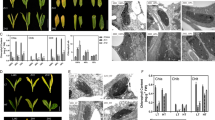Abstract
The developmental regulation of grasses lemma and palea and their relationship to the floral organs in dicots had been variously explicated and extensively debated. Here, we characterized a triangular hull mutant th1-1 from EMS-mutagenized Oryza sativa ssp. indica cv. 93-11. The th1-1 mutant exhibited obviously triangular hull with tortuous and slender lemma/palea. Using a map-based cloning strategy, the TH1 gene was narrowed down to a 60-kb region on the long arm of chromosome 2. Sequence verification revealed that the th1-1 mutant harbored 1-bp deletion in exon 2 of LOC_Os02g56610 which resulted in a frame-shift mutation. The RNA-interference transgenic plants of LOC_Os02g56610 displayed a similar phenotype to the th1 mutant. Consequently, LOC_Os02g56610 was identified as the TH1 gene which encoded 248 amino acids and contained a DUF640 domain. RT-PCR analysis and GUS staining showed that the transcripts of TH1 mainly accumulated in young inflorescence, lemma and palea of spikelet. These results suggested that TH1 was an important gene controlling the lemma and palea development in rice.





Similar content being viewed by others

References
Abebe T, Skadsen RW, Kaeppler HF (2004) Cloning and identification of highly expressed genes in barley lemma and palea. Crop Sci 44:942–950
Ambrose BA, Lerner DR, Ciceri P, Padilla CM, Yanofsky MF, Schmidt RF (2000) Molecular and genetic analyses of the Silky1 gene reveal conservation in floral organ specification between eudicots and monocots. Mol Cell 5:569–579
Bommert P, Nagasawa NS, Jackson D, Hirano HY (2005) Genetics and evolution of inflorescence and flower development in grasses. Plant Cell Physiol 46:69–78
Bowman JL (1997) Evolutionary conservation of angiosperm flower development at the molecular and genetic levels. J Biosci 22:515–527
Chu HW, Qian Q, Liang WQ et al (2006) The FLORAL ORGAN NUMBER4 gene encoding a putative ortholog of Arabidopsis CLAVATA3 regulates apical meristem size in rice. Plant Physiol 142:1039–1052
Clark SE, Running MP, Meyerowitz EM (1993) CLAVATA1, a regulator of meristem and flower development in Arabidopsis. Development 119:397–418
Clark SE, Running MP, Meyerowitz EM (1995) CLAVATA3 is a specific regulator of shoot and floral meristem development affecting the same processes as CLAVATA1. Development 121:2057–2067
Fan CC, Xing YZ, Mao HL, Lu TT, Han B, Xu CG, Li XH, Zhang QF (2006) GS3, a major QTL for grain length and weight and minor QTL for grain width and thickness in rice, encodes a putative transmembrane protein. Theor Appl Genet 112:1164–1171
Jeon JS, Jang S, Lee S et al (2000) leafy hull sterile1 is a homeotic mutation in a rice MADS box gene affecting rice flower development. Plant Cell 12:871–884
Kayes JM, Clark SE (1998) CLAVATA2, a regulator of meristem and organ development in Arabidopsis. Development 125:3843–3851
Li A, Zhang Y, Wu X et al (2008) DH1, a LOB domain-like protein required for glume formation in rice. Plant Mol Biol 66:491–502
Liu F, Ni WM, Griffith ME et al (2004) The ASK1 and ASK2 genes are essential for Arabidopsis early development. Plant Cell 16:5–20
Luo Q, Zhou KD, Zhao XF, Zeng QC, Xia HG, Zhai WX, Xu JC, Wu XJ, Yang HS, Zhu LH (2005) Identification and fine mapping of a mutant gene for palealess spikelet in rice. Planta 221:222–230
McCouch SR, Teytelman L, Xu YB et al (2002) Development and mapping of 2240 new SSR markers for rice (Oryza sativa L.). DNA Res 9:199–207
Prasad K, Sriram P, Kumar CS, Kushalapa K, Vijayraghavan U (2001) Ectopic expression of rice OsMADS1 reveals a role in specifying the lemma and palea, grass floral organs analogous to sepals. Dev Genes Evol 211:281–290
Prasad K, Sriram P, Vijayraghavan U (2005) OsMADS1, a rice MADS-box factor, controls differentiation of specific cell types in the lemma and palea and is an early-acting regulator of inner floral organs. Plant J 43:915–928
Shomura A, Izawa T, Ebana K, Ebitani T, Kanegae H, Konishi S, Yano M (2008) Deletion in a gene associated with grain size increased yields during rice domestication. Nat Genet 40:1023–1028
Sieburth LE, Meyerowitz EM (1997) Molecular dissection of the AGAMOUS control region shows that cis elements for spatial regulation are located intragenically. Plant Cell 9:355–365
Song XJ, Huang W, Shi M, Zhu MZ, Lin HX (2007) A QTL for rice grain width and weight encodes a previously unknown RING-type E3 ubiquitin ligase. Nat Genet 39:623–630
Suzaki T, Sato M, Ashikari M, Miyoshi M, Nagato Y, Hirano H-Y (2004) The gene FLORAL ORGAN NUMBER1 regulates floral meristem size in rice and encodes a leucine-rich repeat receptor kinase orthologous to Arabidopsis CLAVATA1. Development 131:5649–5657
Wang Z, Chen CB, Xu YY, Jiang RX, Han Y, Xu ZH, Chong K (2004) A practical vector for efficient knockdown of gene expression in rice (Oryza sativa L.). Plant Mol Biol Rep 22:409–417
Weng JF, Gu SH, Wan XY et al (2008) Isolation and initial characterization of GW5, a major QTL associated with rice grain width and weight. Cell Res 18:1199–1209
Wu JL, Wu CJ, Lei CL et al (2005) Chemical- and irradiation-induced mutants of indica rice IR64 for forward and reverse genetics. Plant Mol Biol 59:85–97
Yoshimura A, Ideta O, Iwata N (1997) Linkage map of phenotype and RFLP markers in rice. Plant Mol Biol 35:49–60
Yuan Z, Gao S, Xue DW, Luo D, Li LT, Ding SY, Yao X, Wilson ZA, Qian Q, Zhang DB (2009) RETARDED PALEA1 controls palea development and floral zygomorphy in rice. Plant Physiol 149:235–244
Acknowledgments
We thank Prof. Zhizhong Gong for his kindest help. This work was supported by Self-Regulated Projects of State Key Laboratory of Plant Physiology and Biochemistry, and by grants from the National Program of Transgenic Variety Development (2008ZX08009-004, 2008ZX08009-008).
Author information
Authors and Affiliations
Corresponding author
Additional information
Xiaojiao Li and Lianjun Sun contributed equally to this paper.
Electronic supplementary material
Below is the link to the electronic supplementary material.
Rights and permissions
About this article
Cite this article
Li, X., Sun, L., Tan, L. et al. TH1, a DUF640 domain-like gene controls lemma and palea development in rice. Plant Mol Biol 78, 351–359 (2012). https://doi.org/10.1007/s11103-011-9868-8
Received:
Accepted:
Published:
Issue Date:
DOI: https://doi.org/10.1007/s11103-011-9868-8



